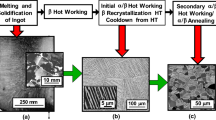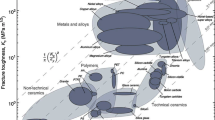Abstract
Enhancement of toughness is currently a critical engineering issue in tungsten metallurgy. The inherent toughness of tungsten single crystals is closely related to the capacity for local plastic slip. In this study we have investigated the plastic behavior of tungsten single crystals by means of micro-indentation experiments performed on specimens exposing (100), (110), and (111) surfaces. In parallel, FEM simulations were carried out with the Peirce–Asaro–Needleman crystal plasticity model considering both {110} 〈111〉 and {112} 〈111〉 slip systems. Plastic material parameters were identified by comparing the measured and predicted load–displacement curves as well as pile-up profiles. It is found that both measured and simulated plastic pile-up patterns on the indented surfaces exhibit significant anisotropy and orientation dependence, although the measured and simulated load–displacement curves manifest no such orientation dependence. The height and extension of pile-ups differ strongly as a function of surface orientation. The FEM simulations are able to reproduce the observed features of spherical indentation both qualitatively and quantitatively.









Similar content being viewed by others
References
Wurster S, Baluc N, Pippan R et al (2013) Recent progress in R&D on tungsten alloys for divertor structural and plasma facing materials. J Nucl Mater 442:181–189
Gumbsch P, Riedle J, Hartmaier A, Fischmeister HF (1998) Controlling factors for the Brittle-to-Ductile transition in tungsten single crystals. Science 282:1293–1295
Wronski A, Fourdeux A (1964) Slip-induced cleavage in polycrystalline tungsten. J Less-Common Metals 6:413–429
Beardmore P, Hull D (1965) Deformation and fracture of tungsten single crystals. J Less-Common Metals 9:168–180
Argon AS, Maloof SR (1966) Fracture of tungsten single crystals at low temperatures. Acta Metal 14:1463–1468
Brunner D, Glebovsky V (2000) Analysis of flow-stress measurements of high-purity tungsten single crystals. Mater Lett 44:144–152
Kaun L, Luft A, Richter J, Schulze D (1968) Slip line pattern and active slip systems of tungsten and molybdenum single crystals weakly deformed in tension at room temperature. Phys Stat Sol 26:485–499
Asaro RJ, Needleman A (1984) Flow localization in strain hardening crystalline solids. Scr Metal 18:429–435
Hutchinson JW (1976) Bounds and self-consistent estimates for creep of polycrystalline materials. Proc R Soc Lond A 348:101–127
Peirce D, Asaro RJ, Needleman A (1982) An analysis of nonuniform and localized deformation in ductile single crystals. Acta Metal 30:1087–1119
Hsiung LL (2010) On the mechanism of anomalous slip in bcc metals. Mater Sci Eng A 528:329–337
Huang Y (1991) A user-material subroutine incorporating single crystal plasticity in the ABAQUS finite element program. Harvard University, Cambridge
Featherston FH, Neighbours JR (1963) Elastic constants of tantalum, tungsten, and molybdenum. Phys Rev 130:1324–1333
Wright SJ (1930) The elasticity of pintsch crystals of tungsten. Proc R Soc Lond A 126:613–629
Zambaldi C, Raabe D (2010) Plastic anisotropy of c-TiAl revealed by axisymmetric indentation. Acta Mater 58:3516–3530
Yao WZ (2012) Crystal plasticity study of single crystal tungsten by indentation tests. PhD Thesis, Ulm University, Ulm
Tabor D (1951) The hardness of metals. Oxford University Press, Oxford
Kothari M (1997) Polycrystalline elasto-viscoplasticity: application to BCC metals. PhD Thesis, MIT, Cambridge
Garfinkle M (1965) Room-temperature tensile behavior of 〈100〉 oriented tungsten single crystals with rhenium in dilute solid solution, Fourth Symposium on Refractory Metals NASA, Indiana
Lassner E, Schubert W-D (1999) Tungsten: properties, chemistry, technology of the element, alloys, and chemical compounds. Springer, Berlin
Chiem CY, Lee WS (1994) The influence of dynamic shear loading on plastic deformation and microstructure of tungsten single crystals. Mater Sci Eng A 187:43–50
Smith R, Christopher D, Kenny SD, Richter A, Wolf B (2003) Defect generation and pileup of atoms during nanoindentation of Fe single crystals. Phys Rev B 67:245405
Acknowledgments
Part of this work was funded by EURATOM (FP7/2007-2011) under Grant Agreement 224752 and coordination action FEMaS. The author W.Z. Yao is also grateful to the Chinese Scholarship Council (CSC) for financial support.
Author information
Authors and Affiliations
Corresponding author
Appendix
Appendix
Method of least squares used for numerical fitting
In this work the reverse fitting scheme is formulated as a minimization problem with respect to the input parameters, where the objective function quantifies the total discrepancy between the experimental results and the corresponding numerical data in load–displacement curves and the selected surface pile-up profiles of imprints.
The objective function is formulated as
where \( \vec{p} \) represents the vector collecting the input parameters to identify; L exp and \( L_{\text{simu}} \) denote the experimental and numerical load–displacement curves, respectively; U exp1, \( U_{{{\text{simu}}1}} \), U exp2, and \( U_{{{\text{simu}}2}} \) are section profiles from experiment and simulation and the subscripts 1 and 2 indicate different paths, i.e., crystallographic direction [001] and [011] in plane (100), along which the cross-section are taken; χ max and ψ max are distances along the selected paths. Obviously, the dependence of the calculated quantities \( L_{\text{simu}} \) and \( U_{\text{simu}} \) on the input parameters in vector \( \vec{p} \) is implicit through the FEM modeling. This indicates the objective function ω is non-explicit and generally non-convex and non-smooth function of \( \vec{p} \).
The minimization of the above objective function \( \omega (\vec{p}) \) starts from a suitably chosen set of initial input parameters, usually those expected on the basis of available literature data or previous experience.
Rights and permissions
About this article
Cite this article
Yao, W.Z., Krill, C.E., Albinski, B. et al. Plastic material parameters and plastic anisotropy of tungsten single crystal: a spherical micro-indentation study. J Mater Sci 49, 3705–3715 (2014). https://doi.org/10.1007/s10853-014-8080-z
Received:
Accepted:
Published:
Issue Date:
DOI: https://doi.org/10.1007/s10853-014-8080-z




